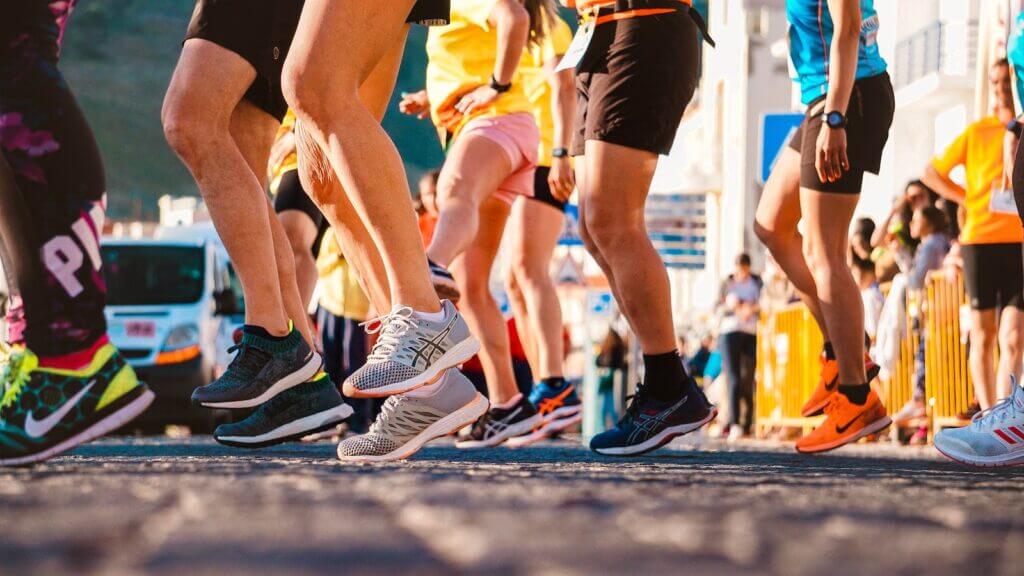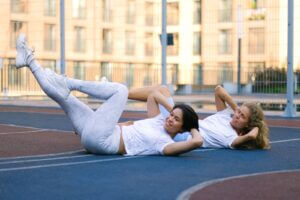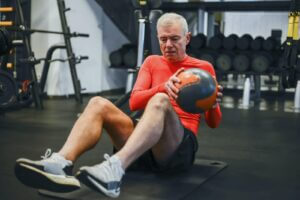Are you ready to take your running performance to new heights? If you’re seeking that extra edge in your training, it’s time to discover the power of leg crossovers. These dynamic and efficient movements have the potential to revolutionize your running game. Whether you’re a seasoned athlete or a beginner looking to enhance your skills, mastering leg crossovers can unlock a whole new level of agility, speed, and coordination.
In this comprehensive guide, we’ll dive deep into the world of leg crossovers, providing you with essential techniques and expert tips to help you achieve improved performance on the track, trail or road. Get ready to elevate your running experience like never before!
Table of Contents
Understanding Leg Crossovers
Leg crossovers may sound like a complicated term, but they’re actually a simple and fun exercise that can make you a better runner! In this section, we’ll explain what leg crossovers are and how they can help you improve your running performance.
1. What are Leg Crossovers?
Leg crossovers are a type of exercise where you swing one leg over the other in a crisscross motion while you’re running or even standing still. It’s like drawing big Xs with your legs! By crossing your legs over each other, you engage different muscles and challenge your body in a unique way.
2. How Leg Crossovers Enhance Running Performance
Leg crossovers are not just a fancy move – they actually have some superpowers that can make you a better runner. Here are a few ways leg crossovers can enhance your running performance:
Improved Agility
When you practice leg crossovers, you train your body to move quickly and change directions smoothly. This helps you become more agile, which means you can avoid obstacles, turn corners, and react faster while running.
Better Coordination
Leg crossovers require coordination between your legs and your brain. As you practice this exercise, your brain, and muscles learn to work together more efficiently, making you a coordinated and balanced runner.
Engaging Important Muscles
Leg crossovers involve several muscle groups, which means you get a full-body workout while having fun! The main muscles involved in leg crossovers are:
Hip Muscles
The muscles around your hips, such as the hip flexors and glutes, get stronger and more flexible when you do leg crossovers. This helps you maintain a good running posture and power your strides.
Core Muscles
Your core muscles, including the abs and back muscles, play a crucial role in stabilizing your body during leg crossovers. A strong core helps you maintain balance and control while running.
Leg Muscles
Leg crossovers work the muscles in your thighs, such as the quadriceps and hamstrings, as well as the calf muscles. These muscles become stronger and more coordinated, giving you the power and endurance you need for running.
To sum things up, leg crossovers are a fun and effective exercise that can improve your running performance in several ways. They enhance your agility, and coordination, and engage important muscles throughout your body. So, the next time you’re out for a run, give leg crossovers a try and enjoy the benefits they bring to your running adventures!
Proper Technique and Form
To perform leg crossovers correctly and get the most out of this exercise, it’s important to follow these step-by-step instructions and remember the key points.
1. Stand Tall and Get Ready
- Start by standing up straight with your feet hip-width apart.
- Imagine a string pulling you up from the top of your head, making you tall and confident.
- Keep your shoulders relaxed and your arms loose by your sides.
2. Step and Cross:
- Lift your right leg slightly and take a step forward and across your body, towards the left side.
- As you bring your right leg forward and across, your left leg should naturally move backward and away from the right leg.
- Aim to create an “X” shape with your legs as they cross over each other.
3. Alternate Sides:
- After crossing your right leg over, bring it back to the starting position.
- Now, it’s time to cross your left leg over your right leg, stepping forward and across towards the right side.
- Remember to maintain a smooth and controlled motion as you alternate the leg crossovers.
4. Engage Your Core:
- Throughout the exercise, focus on engaging your core muscles.
- Imagine a strong and stable center in your belly, keeping your body balanced and supported.
- This will help you maintain proper alignment and posture during leg crossovers.
5. Visualize the Path:
- To help you with the proper technique, imagine drawing an imaginary line on the ground.
- Try to step on this line as you perform the leg crossovers.
- Visualizing the path can assist you in staying on track and maintaining a consistent rhythm.
Remember, it’s important to start slowly and gradually increase your speed as you become more comfortable with the exercise. Take your time to master the correct form and focus on maintaining proper alignment and posture throughout the movement.
Proper alignment and posture are crucial because they help prevent injuries and make your leg crossovers more effective. When you stand tall and keep your body in the right position, it allows your muscles to work together efficiently and helps you become a stronger runner.
So, the next time you go out for a run or practice your leg crossovers, remember these important steps: stand tall, step and cross, alternate sides, engage your core, and visualize the path. By mastering the proper technique and form, you’ll be well on your way to improving your running performance and having lots of fun along the way!
Benefits of Leg Crossovers for Runners

Leg crossovers are not just a fun exercise, but they also bring many advantages to runners like you! Let’s explore some of the amazing benefits they offer:
Supercharge Your Agility and Balance
When you perform leg crossovers, you are training your body to move quickly and change direction with ease. This helps improve your agility, which means you can move faster and more gracefully on your feet. It’s like being a ninja on the running track!
Leg crossovers also help improve your balance. By crossing one leg over the other, you challenge your body to stay stable and centered. This can be very helpful when you encounter uneven terrain or unexpected obstacles while running.
Enhance Your Stride Efficiency
Stride efficiency means running in a way that uses less energy and helps you go farther with each step. Leg crossovers contribute to better stride efficiency by activating and strengthening the muscles in your legs and hips.
When you perform leg crossovers, your muscles learn to work together in a coordinated way, making your movements smoother and more efficient. This can help you run longer distances without feeling tired too quickly.
Prevent Injuries and Muscle Imbalances
Running puts a lot of stress on your body, and sometimes it can lead to injuries or muscle imbalances. But don’t worry, leg crossovers can help!
When you cross your legs over each other, you engage different muscle groups that may not get as much attention during regular running. This helps to balance the strength and flexibility of your leg muscles, reducing the risk of imbalances that can lead to injuries.
Leg crossovers also promote better hip mobility, which is important for runners. Flexible hips allow for a smoother running motion and can help prevent strain or discomfort in your hips and lower back.
Training Drills and Exercises
To improve your leg crossovers and enhance your running performance, it’s important to incorporate specific training drills and exercises into your routine. Here are some exercises that cater to different fitness levels, from beginners to more advanced runners:
1. Standing Leg Swings (Beginner-friendly)
- Stand tall with your feet shoulder-width apart.
- Hold onto a wall or a sturdy object for balance, if needed.
- Swing one leg forward and backward while keeping your upper body stable.
- Repeat for 10-15 swings on each leg, gradually increasing the range of motion.
2. Lateral Leg Swings (Beginner-friendly)
- Stand next to a wall or sturdy object, placing one hand on it for support.
- Swing one leg out to the side, crossing it in front of your opposite leg, and then swing it back out to the side.
- Perform 10-15 swings on each leg, maintaining control and stability throughout the movement.
3. High Knees with Crossovers (Intermediate)
- Begin by jogging in place to warm up your muscles.
- Lift your knees high as you jog, aiming to bring them up towards your chest.
- As you lift your right knee, cross your left hand over your body to touch your right knee.
- Repeat on the other side, crossing your right hand to touch your left knee.
- Continue alternating between high knees and crossovers for 30-60 seconds.
4. Agility Ladder Drill: Lateral Crossovers (Intermediate)
- Set up an agility ladder on the ground or create one using chalk or tape.
- Stand beside the ladder with your feet together.
- Step your right foot into the first square of the ladder, then quickly cross your left foot over your right foot into the next square.
- Step your right foot out of the ladder, followed by your left foot, and repeat the sequence by crossing your right foot over your left foot into the third square.
- Continue this lateral crossover pattern, moving down the ladder, for 3-4 sets of 10-12 repetitions.
5. Single-Leg Crossover Bounds (Advanced)
- Begin by standing on your left leg with your knee slightly bent.
- Leap forward and to the right, crossing your left leg over your right leg in mid-air.
- Land on your right leg and immediately leap forward and to the left, crossing your right leg over your left leg.
- Repeat this bounding motion for a specified distance or time, focusing on explosive power and controlled landings.
- Perform 3-4 sets of 8-10 repetitions on each leg.
Remember to start with the exercises that suit your fitness level and gradually progress to more challenging variations as you become comfortable. Proper technique and control are essential in all exercises to reap the full benefits and minimize the risk of injury.
Integrating Leg Crossovers into a Running Routine
Incorporating leg crossovers into your running routine can be an exciting way to boost your performance and take your running to the next level. Let’s explore some practical tips on how to integrate leg crossovers effectively.
1. Start Slow and Gradually Increase the Intensity
When introducing leg crossovers to your running routine, it’s important to start slow and gradually increase the intensity. Begin by incorporating a few sets of leg crossovers during your warm-up or cool-down sessions. As you become more comfortable and confident with the exercise, you can gradually increase the number of sets or incorporate them into your main workout.
2. Choose the Right Surface
Selecting the right surface for performing leg crossovers is crucial for both safety and effectiveness. Look for a flat, even surface such as a grassy field, track, or well-maintained sidewalk. Avoid uneven or slippery surfaces to prevent any accidents or injuries.
3. Warm-Up Before Leg Crossovers
Before diving into leg crossovers, make sure to warm up your muscles properly. Engage in a light jog, dynamic stretches, or any other warm-up exercises that get your blood flowing and prepare your body for the workout ahead. Warming up helps prevent muscle strain and improves flexibility.
4. Integrate Leg Crossovers in Various Running Scenarios
To maximize the benefits of leg crossovers, consider incorporating them into different running scenarios. Here are a few ideas to get you started:
High-Intensity Intervals
Add leg crossovers during your high-intensity interval training (HIIT) sessions. Perform bursts of leg crossovers for a designated period, followed by a short recovery period. This will help improve your speed, agility, and cardiovascular endurance.
Hill Training
Include leg crossovers as part of your hill training routine. As you ascend or descend a hill, incorporate leg crossovers to challenge your leg muscles further and enhance your stability and balance.
Long-Distance Runs
During longer runs, you can integrate leg crossovers as a form of active recovery. Take short breaks from running and perform sets of leg crossovers to engage different muscle groups and maintain your overall running form.
5. Listen to Your Body and Progress Gradually
While it’s exciting to introduce a new exercise like leg crossovers, it’s essential to listen to your body and progress gradually. Pay attention to any discomfort or pain during the exercise. If you experience any unusual pain, it’s best to consult with a healthcare professional or a running coach.
Remember, the key to success lies in consistency and patience. Over time, as you continue to integrate leg crossovers into your running routine, you’ll notice improvements in your running performance, agility, and overall strength.
By integrating leg crossovers strategically and progressively, you can take full advantage of their benefits and experience an exciting transformation in your running abilities.
Common Mistakes and How to Avoid Them
When it comes to mastering leg crossovers, it’s essential to be aware of common mistakes that can hinder your progress. By understanding these pitfalls and learning how to avoid them, you can maximize the effectiveness of your leg crossover training. Let’s take a look at some common mistakes and how you can steer clear of them:
1. Incorrect Foot Placement: Get Your Feet in the Right Position
One common mistake is placing your feet too far apart or too close together during leg crossovers. This can throw off your balance and diminish the exercise’s benefits. To avoid this, ensure that your feet are hip-width apart before starting. Maintaining this proper foot placement will allow for smoother movement and better coordination.
2. Rushing Through the Exercise: Slow and Steady Wins the Race
Another mistake is rushing through leg crossovers without focusing on form and control. Remember, it’s not about how fast you can do them; it’s about executing each movement with precision. Slow down and concentrate on maintaining proper technique throughout the exercise. This deliberate approach will help engage the target muscles and enhance your balance and coordination.
3. Neglecting Core Stability: Engage Your Core Muscles
A common oversight during leg crossovers is neglecting core stability. Your core muscles play a vital role in maintaining balance and control during the exercise. Engage your abdominal muscles by pulling your belly button in towards your spine. This will help stabilize your torso and enhance the effectiveness of the leg crossovers.
4. Overstriding: Find the Right Range of Motion
Overstriding occurs when you extend your legs too far during leg crossovers, resulting in exaggerated movements that can strain your muscles. Instead, aim for a comfortable range of motion where your feet cross over without overreaching. By keeping the movements within a natural and controlled range, you’ll reduce the risk of injury and promote efficient muscle engagement.
5. Lack of Coordination: Practice Makes Perfect
Coordination plays a crucial role in leg crossovers. If you find yourself struggling to coordinate the movements of your legs and arms, don’t worry—it takes practice. Start with slower and more deliberate crossovers, gradually increasing the speed as you become more comfortable. Consistent practice will improve your coordination over time.
6. Ignoring Upper Body Movement: Sync Your Arms and Legs
Remember that leg crossovers involve both your lower and upper body. Neglecting the movement of your arms can disrupt the flow and effectiveness of the exercise. Sync your arm movements with your leg crossovers by swinging your opposite arm forward as your leg crosses over. This coordination will help improve overall balance and enhance the benefits of the exercise.
By being aware of these common mistakes and actively working to avoid them, you’ll optimize your leg crossover training. Remember, practice makes perfect, so stay patient, stay focused, and keep pushing forward. With determination and proper technique, you’ll soon master leg crossovers and reap the rewards in your running performance.
Conclusion
In conclusion, mastering leg crossovers can significantly improve your running performance. By incorporating these techniques into your training routine, you’ll enhance your agility, coordination, and overall efficiency. Leg crossovers offer a range of benefits, including injury prevention and muscle balance. Remember to maintain proper form and alignment, gradually progress your training, and integrate leg crossovers strategically into your runs.
Whether you’re a beginner or an experienced runner, unlocking the power of leg crossovers will take your performance to new heights. Embrace the challenge, stay consistent, and enjoy the rewarding results on your journey to becoming a stronger, more agile runner.

